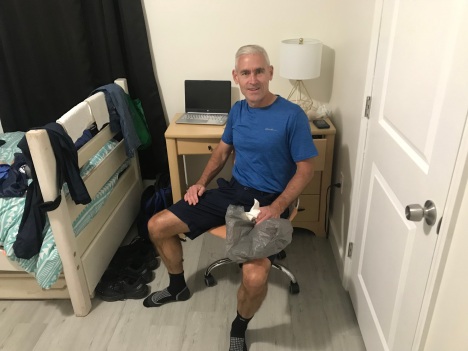
This year’s rendition of Best Convention Ever had a unique spin to it, as it seemed everyone walked away happy with the outcome of their draft.
Clearly some teams were drafting for the here-and-now and some were looking longer term, but somehow everyone seemed content with their haul.
The 15-round draft to kick off the 45th season of the I-75 League saw nine managers in attendance in Phoenix and six more drafting remotely, and the draft came off without a hitch once we figured out where Google moved the chat function to on Google Sheets.






Jet’s Pizza provided some mid-draft nourishment for onsite managers. Plenty of spring training action entertained the gang before and after the draft, with most of the managers taking in Mariners-Brewers on Saturday and Rangers-Angels on Monday.
We (me) lost a key to the Strat house and had to overcome an encounter with a tire slasher, but those were the worst of the tragedies. Nobody gagged on drafting enough at-bats or innings, nobody tried to draft someone who was already taken.
Jamin Rader made his first convention appearance and George Scienski made his second, joining a veteran crew of convention regulars: Dave Renbarger, Gary Kicinski, Mike Renbarger, Steve Hart, and John/Jason/Ryan Renbarger. Former manager Ken Kuzdak and Lynn Renbarger were also on hand.
No one had any clue what the Bismarck Bombers were going to do with the first pick, but they managed to take the guy the Carpe Diem OmegaWatts were planning to take with the second pick — Rockies star Nolan Jones. The OmegaWatts drowned their sorrows by adding yet another 40-homer hitter to their beastly lineup in Marcell Ozuna.
With picks at 3 and 5, Applegate went after the highest-ceiling pitcher and highest-ceiling hitter in the land, Eury Perez and infielder Elly De La Cruz. It took less than a week for Perez to get injured and De La Cruz likely won’t be far behind. With the sandwich pick at 4, after apparently lusting after Perez, West Atlanta settled for Dodgers ace Bobby Miller.
Bushwood was next up at 6 and 8, and it landed top-of-the-round prospect quality in picks Royce Lewis (6) and Evan Carter (8). Between those selections, Boulder snagged Reds middle infielder Matt McLain to handle the bulk of the second-base load.
Catcher Yainer Diaz fell all the way to Superior at No. 9, and South Grand Prairie began its run of prospects by taking Grayson Rodriguez at No. 10.
Starting pitchers also went at 11 and 13, with Dyersville claiming Tanner Bibee and Margaritaville happily landing Kodai Senga. At 12, Olympic Coast added some right-handed thunder with first baseman Wilmer Flores.
The New New York Hypnotoads finished off the first round by filling their second-base void with Zack Gelof at 14 and bolstering their backstop ranks with highly touted catcher Francisco Alvarez at 15.
Still that left many top-quality players for the second and third round too, and suddenly what was billed in advance as a potentially “weak” draft didn’t seem so bad afterall. Some other draft highlights:
- Bismarck tabbed four Tigers among its first seven picks (Tyler Holton, Alex Lange, Jake Rogers and Parker Meadows.)
- If he’d been available a year ago, Jordan Walker might have gone high in the first round; a ‘5’ fielding rating must have scared people away this year and Applegate landed him in the second round at pick 21. Noelvi Marte‘s stock rightfully dropped following news of his half-season suspension, but the Paperclips think he’s a bargain as a fifth-round pick at 72.
- The wheeling-and-dealing Hypnotoads traded away their second-, third-, fourth- and fifth-round draft picks and made several in-draft maneuvers to position themselves to snag a desired player. Their success this year might hinge on the effectiveness of their “I’ll get starters at the end” strategy, as Andrew Abbott, Tanner Houck and James Paxton were taken in three of the last four rounds, barely dragging New New York across the 1,500-inning finish line at 1,501.
- South Grand Prairie loaded up on young arms, following up its GrayRod selection with Taj Bradley, Bryce Miller, Bryan Woo and J.P. France.
- Dyersville and Tatooine were also active traders; the Treblemakers swapped six of their original picks and the Rebels five; Tatooine’s maneuvers included their first, and fourth-through-seventh-round picks. The Rebels’ strategy was to deal picks for players prior to the draft rather than pick up sloppy seconds while drafting at the back of each round.
- In the 12th round, Savannah nabbed Super Freak Dairon Blanco, who already put his pinch-running abilities into practice by swiping a base and scoring the tying run in the Scorpions’ come-from-behind win in Game Five of their season-opening series with Applegate. Yow.
- Mr. Irrelevant honors went to Kyle Farmer, a seven-position player whom the Bombers reclaimed after opting not to retain him at the end of the 2023 season.
And with that, for the 45th time in league history, it’s time to play ball!
Filed under: 2024 season, Convention, Draft | Tagged: I-75 Strat-O-Matic League, Strat-O-Matic, Strat-O-Matic baseball | Leave a comment »















